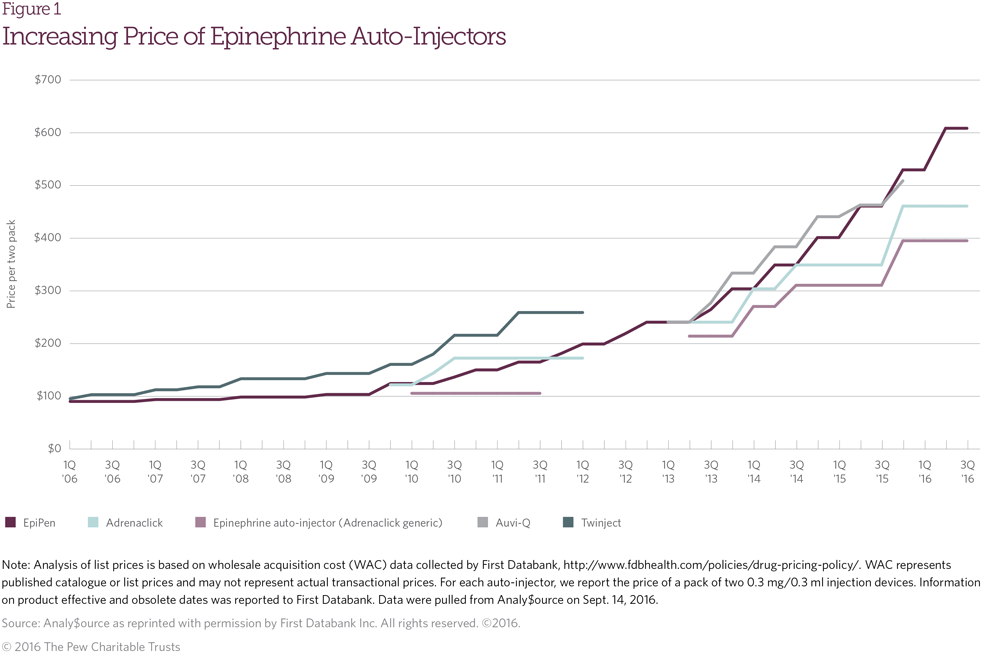Beyond EpiPen: Prices of Lifesaving Epinephrine Products Soar
Competition has failed to drive down prices, leaving policymakers demanding answers
 © iStock
© iStockDrastic prices increases for epinephrine auto-injectors—used to treat severe allergic reactions, including to peanuts and bee stings—have generated outrage from both patients and policymakers.
People with life-threatening allergies have long relied on the EpiPen, an injection device that dispenses epinephrine, to reverse symptoms of severe allergic reactions. But steep price increases for the drug over the past decade—including a more than 100 percent increase in the past three years—have sparked outrage from consumers who now face sizable, and often unaffordable, out-of-pocket costs.
Federal policymakers have asked Mylan, the product’s manufacturer, to explain its pricing decisions, and the House Oversight and Government Committee initiated a formal investigation into the drug’s costs. Many policymakers have advocated for increased competition to drive down EpiPen prices. However, two versions of another epinephrine auto-injector on the market—Impax Laboratories’ brand-name Adrenaclick and a generic—have not lowered prices. In fact, the prices for all three products have increased significantly.
Over the past 11 years, the list price of EpiPen has increased 574 percent—from $90.28 in 2006 to $608.62 today. Since early 2014, EpiPen’s price has doubled. The price of the other available auto-injectors, including brand and generic versions of Adrenaclick, have also increased substantially since 2014—by 52 and 46 percent, respectively. (Importantly, these prices do not account for discounts or rebates the manufacturers provide to purchasers. But even with these discounts, prices have increased.)1
Notably, the Food and Drug Administration has determined that EpiPen and Adrenaclick are not therapeutically equivalent due to design differences.2 For this reason, states generally do not allow pharmacists to automatically substitute the lower-cost Adrenaclick for EpiPen without provider consent.3
Increases in demand
Demand for epinephrine auto-injectors has also increased. The number of EpiPen prescriptions in the U.S. rose from approximately 2.5 million to more than 3.5 million between 2011 and 2015.4 The number of schools stocking the products has also risen.5 Mylan acquired EpiPen in 2007, when sales totaled $200 million.6 Today, sales exceed $1 billion,7 due in part to price increases, new state and federal policies, and changes in the auto-injector marketplace. For example, some states have passed laws requiring schools to stock epinephrine-delivery devices.8
Epinephrine Auto-Injectors: A History
1987
EpiPen is approved by FDA.
2009
FDA allows EpiPen to be marketed to anyone at risk for anaphylaxis.9 Previously, the auto-injector could be marketed only to patients with a history of anaphylactic reaction.
2010
Brand and generic versions of Adrenaclick are launched in the U.S.10
A National Institutes of Health expert panel recommends that patients be prescribed two doses of epinephrine instead of just one.11
2011
The generic version of Adrenaclick is discontinued.12
2012
Shionogi, which had acquired both Twinject (launched by Verus Pharmaceuticals in 2005)13 and the branded version of Adrenaclick, discontinues both products.14
Mylan launches the “EpiPen4Schools” program, which offers free and discounted EpiPens to schools.15 Today, more than 65,000 schools receive free EpiPens through the program, while an unknown number purchase the injectors—which expire after 12-18 months—from Mylan every year at a discount.16
2013
Auvi-Q launches in the U.S.17 after receiving FDA approval in late 2012.18
Both the brand and generic versions of Adrenaclick are re-launched into the U.S. market.19
The Centers for Disease Control and Prevention releases voluntary guidelines recommending that schools keep multiple doses of epinephrine available on-site.20
The federal School Access to Emergency Epinephrine Act becomes law.21 It provides financial incentives for states to require schools to maintain an emergency stock of epinephrine and permit trained personnel to administer the drug during the school day. As of July, according to Food Allergy Research and Education (FARE), 49 states have laws or guidelines that either require or allow schools to stock epinephrine.22
2015
Sanofi voluntarily recalls the auto-injector Auvi-Q after it is found to potentially deliver the wrong dosage.23
2016
Teva discloses that it received an FDA rejection for its generic version of EpiPen due to “certain major deficiencies.”24 A launch of the product is not anticipated before late 2017 or 2018.25
EpiPen, along with brand and generic versions of Adrenaclick, are the remaining epinephrine auto-injectors available in the U.S.
Generics are just part of the solution
Generics typically save patients and the health care system money because they cost 15 to 20 percent of the brand drug they copy, with prices lowest when multiple generic options are available.26 Although EpiPen was first introduced in 1987, successive changes to the auto-injector have resulted in patent protections through 2025.27 However, under the provisions of a 2012 court settlement, Teva could have begun selling a generic version of EpiPen in June 2015 (or earlier, under certain circumstances), subject to approval by FDA.28 Nevertheless, with only a single generic competitor on the horizon, the effect of generic competition is likely to be limited—at least in the short term. Other generic developers would have to successfully challenge the EpiPen patents in court or, like Teva, settle with Mylan before they could bring a generic version of EpiPen to market.
Mylan has announced plans to release its own generic version of EpiPen for $300,29 which is equal to the price of the brand version two years ago. Other generic developers launching their products before 2025 are likely to set similarly high prices. For these reasons, policymakers who want to address the cost of epinephrine auto-injectors should not rely solely on the future availability of generics.
Policies for consideration
Competition from other auto-injectors, including Adrenaclick, has failed to drive down costs. To lower spending on epinephrine auto-injectors, policymakers could consider the following:
- Reform patent law: Though the initial EpiPen patent was granted in 1977,30 recently awarded patents have extended its protection from generic competition until 2025.31 While the patent system is designed to encourage innovation, some policy experts have raised concerns that allowing patent holders to continuously extend protection for existing products—referred to as “evergreening”—can discourage competition and increase costs.32
- Modify state pharmacy substitution laws: Many states allow automatic substitution of one drug for another at the pharmacy counter when the different medications are determined by FDA to be therapeutically equivalent. These laws could be modified to allow automatic substitution of safe and effective FDA-approved products that are pharmaceutically equivalent but administered via different auto-injectors. Ensuring that patients receive proper training on how to use a substitute product would be important with such an approach.
- Negotiate with competing manufacturers for school purchases: The federal or state governments could negotiate directly with competing epinephrine auto-injector developers and agree to purchase the product from the manufacturer with the lowest acceptable bid.
- Implement a supply schedule for schools: For school purchases, the federal or state governments could set a maximum price to pay for epinephrine auto-injectors. Drug manufacturers would then be required to accept the mandated payment amount or suffer lost revenue.
Endnotes
- Dan Mangan and Anita Balakrishnan, “Mylan CEO Bresch: ‘No One’s More Frustrated Than Me’ About EpiPen Price Furor,” CNBC, Aug. 25, 2016, http://www.cnbc.com/2016/08/25/mylan-expands-epipen-cost-cutting-programs-after-charges-of-price-gouging.html. For example, Mylan announced in August that net sales from EpiPen were $274 for two pens. This discounted amount is still a 200 percent increase in price compared to the nondiscounted price of the auto-injector at the beginning of 2006.
- U.S. Department of Health and Human Services, Food and Drug Administration, “Approved Drug Products with Therapeutic Equivalence Evaluations (36th Edition),” last updated December 31, 2015, http://www.fda.gov/downloads/Drugs/DevelopmentApprovalProcess/ UCM071436.pdf; EpiPen has been assigned a BX code by FDA, meaning that it is not considered therapeutically equivalent to other epinephrine auto-injectors.
- Jeff D. Prescott, “Considerations for the Pharmacist About Anaphylaxis Epinephrine Auto-Injectors,” Pharmacy Times, June 19, 2015, http://www.pharmacytimes.com/publications/issue/2014/august2014/ r658_august2014_re.
- Lydia Ramsey, “There Are Alternatives to the EpiPen, but Nobody Seems to Know About Them,” Business Insider, Sept. 13, 2016, http://www.businessinsider.my/epipen-prescriptions-auvi-q-adrenaclick-2016-9/#QPGVwhFfI1Q8B2Qc.97.
- Ben Popken, “Industry Insiders Estimate EpiPen Costs No More Than $30,” NBC News, Sept. 6, 2016, http://www.nbcnews.com/business/consumer/industry-insiders-estimate-epipen-costs-no-more-30-n642091.
- Cynthia Coons and Robert Langreth, “How Marketing Turned the EpiPen Into a Billion-Dollar Business,” Bloomberg Businessweek, Sept. 23, 2015, http://www.bloomberg.com/news/articles/2015-09-23/how-marketing-turned-the-epipen-into-a-billion-dollar-business.
- Ibid.
- Food Allergy Research & Education, “School Access to Epinephrine Map,” last modified July 6, 2016, https://www.foodallergy.org/advocacy/epinephrine/map.
- Food and Drug Administration, letter to Meridian Medical Technologies Inc. regarding its supplemental new drug application for EpiPen and EpiPen Jr. auto-injectors, May 19, 2009, http://www.accessdata.fda.gov/drugsatfda_docs/appletter/2009/019430s047ltr.pdf.
- Business Wire, “Sciele Introduces Adrenaclick (Epinephrine Injection, USP) Auto-Injector for the Emergency Treatment of Anaphylaxis,” Jan. 7, 2010, http://www.businesswire.com/news/home/20100107006249/en/Sciele-Introduces-AdrenaclickTM-epinephrine-injection-USP-Auto-Injector; and National Institutes of Health, “Archived Drug Label: Epinephrine, Epinephrine Injection—Greenstone LLC,” revised December 2010, https://dailymed.nlm.nih.gov/dailymed/archives/fdaDrugInfo.cfm?archiveid=44610.
- Joshua A. Boyce et al., “Guidelines for the Diagnosis and Management of Food Allergy in the United States: Report of the NIAID-Sponsored Expert Panel,” The Journal of Allergy and Clinical Immunology, 126 no. 6(2010): s1-s58, http://dx.doi.org/10.1016/j.jaci.2010.10.007.
- This conclusion is from Pew’s analysis of the obsolete date of the generic Adrenaclick National Drug Code (NDC), as reported by the drug manufacturer to First DataBank in July 2011.
- PR Newswire, “Verus Pharmaceuticals Announces U.S. Launch of Twinject for Anaphylaxis,” Aug. 16, 2005, http://www.prnewswire.com/news-releases/verus-pharmaceuticals-announces-us-launch-of-twinject-for-anaphylaxis-54875892.html.
- “Adrenaclick Auto-Injector Available Again for Anaphylaxis,” Monthly Prescribing Report, June 17, 2013, http://www.empr.com/news/adrenaclick-auto-injector-available-again-for-anaphylaxis/article/298979/; Alicia McElhaney, “Mylan’s Time Leaning on EpiPens Is Rapidly Approaching an End,” The Street, August 10, 2016, https://www.thestreet.com/story/13646012/1/mylan-s-time-leaning-on-epipens-is-rapidly-approaching-an-end.html.
- Mylan Specialty LP, “EpiPen4Schools,” accessed Sept. 20, 2016, https://www.epipen4schools.com/About.
- Ike Swetlitz and Ed Silverman, “Mylan May Have Violated Antitrust Law in Its EpiPen Sales to Schools, Legal Experts Say,” Stat, Aug. 25, 2016, https://www.statnews.com/2016/08/25/mylan-antitrust-epipen-schools.
- PR Newswire, “Sanofi Announces Auvi-Q, the First and Only Voice-Guided Epinephrine Auto-Injector, Is Now Available in the U.S.,” Jan. 28, 2013, http://www.prnewswire.com/news-releases/sanofi-announces-auvi-q-the-first-and-only-voice-guided-epinephrine-auto-injector-is-now-available-in-the-us-188651061.html.
- Sanofi, “Sanofi Announces FDA Approval for Auvi-Q, First Voice-Guided Epinephrine Auto-Injector for Patients With Life-threatening Allergies,” news release, Aug. 13, 2012, http://en.sanofi.com/Images/30999_20120813_EAI_FDA_APPROVAL_en.pdf.
- PR Newswire, “Amedra Pharmaceuticals Markets Adrenaclick Auto-Injector,” June 14, 2013, http://www.prnewswire.com/news-releases/amedra-pharmaceuticals-markets-adrenaclick-auto-injector-211586831.html; and PR Newswire, “Lineage Therapeutics Markets Authorized Generic Epinephrine Auto-Injector,” June 14, 2013, http://www.prnewswire.com/news-releases/lineage-therapeutics-markets-authorized-generic-epinephrine-auto-injector-211585371.html; Both versions of Adrenaclick were launched after being acquired by Amedra Pharmaceuticals. The generic version was purchased by an Amedra subsidiary, Lineage Therapeutics. Both companies were eventually acquired by Impax Laboratories, which currently manufacturers both versions of Adrenaclick.
- Centers for Disease Control and Prevention, Voluntary Guidelines for Managing Food Allergies in Schools and Early Care and Education Programs (2013), http://www.cdc.gov/healthyyouth/foodallergies/pdf/ 13_243135_a_food_allergy_web_508.pdf.
- White House Blog, “President Obama Signs New EpiPen Law to Protect Children With Asthma and Severe Allergies, and Help Their Families to Breathe Easier,” blog entry by Valerie Jarrett, Nov. 13, 2013, https://www.whitehouse.gov/blog/2013/11/13/president-obama-signs-new-epipen-law-protect-children-asthma-and-severe-allergies-an.
- Food Allergy Research & Education, “School Access to Epinephrine Map.”
- Food and Drug Administration, “Updated: Sanofi US Issues Voluntary Nationwide Recall of All Auvi-Q Due to Potential Inaccurate Dosage Delivery” (Oct. 30, 2015), http://www.fda.gov/Safety/Recalls/ucm469980.htm.
- Carly Helfand, “FDA Swats Down Teva’s EpiPen Copy, Putting Mylan in Cruise Control,” FiercePharma, March 1, 2016, http://www.fiercepharma.com/sales-and-marketing/fda-swats-down-teva-s-epipen-copy-putting-mylan-cruise-control.
- Ransdell Pierson and Deena Beasley, “Teva Says Aims to Launch Epi-Pen-Like Device by 2018 in U.S.,” Reuters, Sept. 9, 2016, http://www.reuters.com/article/us-teva-pharm-ind-epipen-idUSKCN11F25K.
- Food and Drug Administration “Generic Competition and Drug Prices,” last modified May 13, 2015, http://www.fda.gov/AboutFDA/CentersOffices/ OfficeofMedicalProductsandTobacco/CDER/ucm129385.htm.
- Andrew Pollack, “Mylan Raised EpiPen’s Price Before the Expected Arrival of a Generic,” The New York Times, Aug. 24, 2016, http://www.nytimes.com/2016/08/25/business/mylan-raised-epipens-price-before-the-expected-arrival-of-a-generic.html.
- Phil Milford, “Mylan, Pfizer Reach Epinephrine-Pen Settlement With Teva,” Bloomberg Technology, April 26, 2012, http://www.bloomberg.com/news/articles/2012-04-26/mylan-pfizer-announce-epinephrine-pen-settlement-with-teva-1-.
- Mylan NV, “Mylan to Launch First Generic to EpiPen Auto-Injector at a List Price of $300 Per Two-Pack Carton, a More than 50% Discount to the Brand Product,” news release, http://newsroom.mylan.com/2016-08-29-Mylan-to-Launch-First-Generic-to-EpiPen-Auto-Injector-at-a-List-Price-of-300-per-Two-Pack-Carton-a-More-than-50-Discount-to-the-Brand-Product.
- Sheldon Kaplan et al., “United States Patent: 4,031,893—Hypodermic Injection Device Having Means for Varying the Medicament Capacity Thereof,” June 28, 1977, http://patents.com/us-4031893.html.
- Samantha Liss, “Behind the EpiPen Controversy Are Questions About Patents Granted to Drugmaker,” St. Louis Post-Dispatch, Sept. 4, 2016, http://www.stltoday.com/business/local/behind-the-epipen-controversy-are-questions-about-patents-granted-to/article_54bbc38b-57b1-5a41-bbe4-a92aa9f85751.html.
- Tahir Amin and Aaron S. Kesselheim, “Secondary Patenting of Branded Pharmaceuticals: A Case Study of How Patents on Two HIV Drugs Could Be Extended for Decades,” Health Affairs 31 no. 10 (2012): 2286–94.







